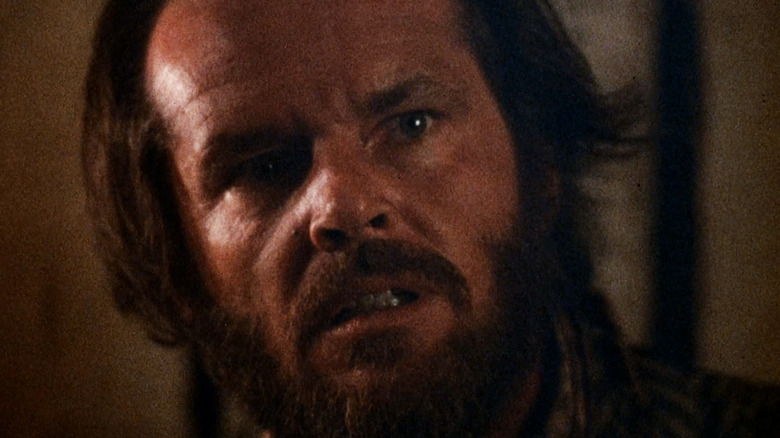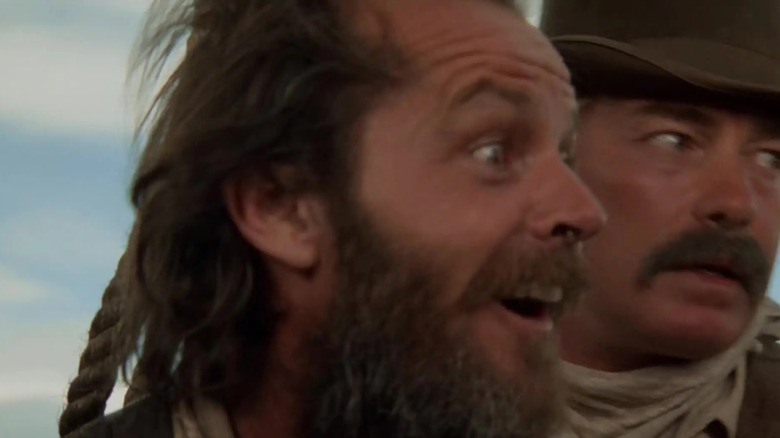Why Jack Nicholson Didn’t Make A Lot Of Westerns

The now reclusive Jack Nicholson is a true cultural icon, to the extent that even established Hollywood legends are starstruck in his presence. He belongs to a bygone era of movie stars but is still very much with us, making the fact he hasn’t appeared in a film since 2010’s star-studded box office flop “How Do You Know,” all the more disappointing.
The reasons why Nicholson disappeared from Hollywood are complicated, but one aspect has to do with the Marvel-ification of everything. Speaking to the Sydney Morning Herald in 2013, the veteran star said that he was really only concerned with making “films that move people” and had observed that “maybe people in their 20s and 30s don’t actually want to be moved anymore.” For Nicholson, “more bombs” and “more explosions” were the new norm, and he was adamant that he’d “never do that type of movie.”
Clearly, Nicholson doesn’t need the money, especially since he took Warner Bros. for a ride with “Batman” (1989) and basically secured most of the profits for himself. But his choice to withdraw from the spotlight seems deeper than a lack of financial incentive. Stanley Kubrick once described Nicholson as having an “unactable” quality: intelligence. While he’s become known for his roguish charm, the actor has always been much more perceptive and insightful than his reputation might suggest, and if he doesn’t like the state of moviemaking today, he’s probably onto something. His own intuitions haven’t steered him wrong thus far. Even during the early days of his career, he was careful to avoid making too much of a certain type of movie in order to ensure the remarkable longevity that he’s since demonstrated.
Jack Nicholson intentionally limited his Western roles
The list of Jack Nicholson’s most iconic roles is, as you might expect, quite a long one. The man has been around for long enough to amass an impressive filmography, but he’s also managed to remain relevant and sought-after throughout his career going all the way back to his film debut in the 1958 Roger Corman noir “The Cry Baby Killer.” When someone reaches Nicholson-levels of fame, it’s strange to think that they were ever a struggling young actor, but he very much was at this time. Indeed, he starred in several B-movie projects and wrote a handful of scripts for underseen films such as 1963’s “Thunder Island” and 1964’s “Flight to Fury” before he got his big break with 1969’s “Easy Rider.”
Once the role of George Hanson in Dennis Hopper’s seminal road drama came along, Nicholson was ready … and not just because he’d been waiting so long. The young actor had specifically ensured he was trained to a high enough level that, should the B-movie seas part to reveal the role of a lifetime, he was prepared to handle it. Nicholson’s one piece of advice to aspiring actors is to “study” and “invest” in yourself so that you’re ready when your break comes.
But it seems another piece of advice the screen legend might offer is to limit your exposure in a certain genre. Speaking to the New York Times in 1994, the actor talked about the importance of not being pinned down. “Once you’re successful in a film, you tend to have to repeat it,” he noted. “And it’s a trap. And I’ve tried not to get pigeonholed doing a lot of Westerns, a lot of rednecks, a lot of dope films. And I’m always aware when they’re trying to write a ‘Jack’ scene. You know, ‘Let him run wild.'”
Jack Nicholson only ever appeared in five Westerns
Throughout his more than five-decade career, Jack Nicholson has only starred in five Westerns, most of which were during the early years. His sixth big screen appearance and first role in a Western came with 1962’s “The Broken Land,” in which he played a falsely-accused resident of a small town who teamed up with cowboy loner Dave Dunson (Robert Sampson) to take down a corrupt sheriff. Monte Hellman’s 1966 film “The Shooting” was Nicholson’s second Western, in which he played nefarious gunslinger Billy Spear. That same year, he also portrayed a cowboy named Wes in Hellman’s “Ride in the Whirlwind” which he additionally wrote and co-produced.
After that, it would be a full decade until Nicholson returned to the genre, playing rustler Tom Logan in Arthur Penn’s 1976 Western “The Missouri Breaks.” That film was much more well-received than his two 1966 Westerns and was notable for having the actor face off against his longtime friend Marlon Brando in the role of regulator Lee Clayton. Nicholson’s final Western was 1978’s “Goin’ South,” which he directed and starred in as the outlaw Henry Moon, with the movie ultimately faring … okay with critics. This was the last time Nicholson would have anything to do with a Western, however, which might have had something to do with his on-set feud with John Belushi.
After this, Hollywood would never convince Nicholson to give the good old-fashioned oater another go. Still, choosing not to appear in many Westerns didn’t hurt the man one bit. In fact, judging by his three Oscars and the fact he holds the most nominations in the Academy’s history, with 12, Nicholson was onto something with his aversion to “Westerns,” “rednecks” and “dope films.”
Source link








